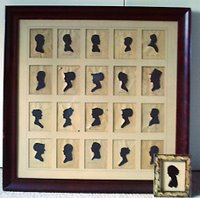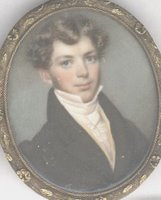
Rarity
American miniatures are more rare than may be commonly assumed. In his 1832 Gazetteer, Bishop Davenport recorded many interesting facts about the United States in the early years of the 19C. For example in 1820 the population of Boston was about 50,000, NYC was under 150,000, and Philadelphia was 65,000. The total population of USA went from 3.9 million in 1790 to 12.9 million in 1830. Most of these people lived in the countryside and others were slaves or from the working classes.
Thus there were few people who could afford to have miniatures painted in America in comparison to those in Europe, especially when it is considered America was at war with England during the American Revolution, and again after 1800. It is also likely some American miniatures were lost during the Civil War period.

There is a table in Blattel's Dictionary of Miniature Painters showing the number of miniature painters by country. Many of these are known by name only and may have painted only one or two miniatures each. The total number of miniaturists listed for France, Germany, and Great Britain is in the range of 7000 to 7500 for each country, approximately 22,000 in total, plus about 7000 for Austria and Italy combined, together with 6,000 for the rest of Europe, which totals close to 35,000 for Europe. After eliminating the pre 1750 artists and assuming 100 surviving miniatures per European painter, there may be as many as 2,000,000 European miniatures still in existence.
However, for USA the total number of miniature painters is only about 1800 and, of this, the number of early 19C American artists who painted more than 100 miniatures is probably under 500, with a similar number from the early 20C painting less than 100 miniatures. However, assuming 1800 American miniature painters at 100 surviving miniatures for each painter, suggests there are less than 200,000 American miniatures in existence. That is only 10% of the estimated total for European miniatures.
In theory this makes the prospect of successfully attributing unsigned American miniatures to specific artists, much more likely than for European artists. However, unfortunately, the literature on American artists is not extensive and there is no comprehensive dictionary of American artists which includes examples of the work of each artist.
 American Style and Attributions
American Style and AttributionsMany American miniatures are unsigned, some are also close in style to British or European painters, which is not surprising as many painters emigrated to America. Thus it can be difficult to attribute miniatures to specific artists, or even to the country of origin. However, by studying styles and in particular frames, it is possible to be fairly certain of the country of origin. However, it is recognized there may be errors in the collection and there may be a few British ones included as American in error.
American miniatures being such a specialised, but sadly unfashionable, field of collecting means that there are few real experts on the subject. This collector expects that experts on American miniatures may justifiably question some of the attributions made. However, a major reason for posting these images, is to allow knowledgeable collectors or experts to comment on attributions and hence any correcting comments will be very welcome. If desired, expert comment can be left anonymously.
In return, it is hoped that the images and comments on the website will help add to the general pool of knowledge on the subject.

American Galleries
The American miniature portraits and silhouettes are displayed in four galleries and a total of around 360 individual portraits can be viewed.
American 1 Gallery - includes 18C and 19C artists, together with more interesting sitters from that period by unknown artists. The section includes the examples shown by James Peale, Nathaniel Rogers, Anna Claypoole Peale, and John Wood Dodge. Interesting sitters included in the section are Aaron Burr, Theodosia Burr Alston, and Commodore Matthew Perry. These miniatures are in approximate alphabetical order of artist or sitter - to view about 110 of them, go to American 1
American 2 Gallery - includes the remainder of 19C artists, mostly unsigned and the sitters unidentified. With some exceptions, they are listed in approximate date order. To view about 120 of them, go to American 2
American 3 Gallery - As the other three American Galleries have grown to be quite large, an overflow Gallery has been created in early 2008 which will hold all new additions from the 18C, 19C, and 20C, see
 American 3
American 3American 20C Gallery - includes the late 19C artists and 20C artists and most of these miniatures are signed. These American 20C portraits are available to view in approximate alphabetical order of artist. The section includes miniatures by William Jacob Baer and Eulabee Dix. To view about 110 of them, go to American 20C
American Silhouettes. In principle, these are outside the scope of the collection, with one significant exception. This is the group of 20 silhouettes of the Garrigues family shown above which now form part of the collection. These were cut at the Charles Willson Peale Museum and around half of them have the Peale Museum impression. A previous owner of this frame loaned it to the Garrigues family for inclusion in their family history website, thus the 20 identified silhouettes can best viewed individually at Charles Willson Peale Silhouettes of Garrigues & Davis Families circa 1820-1825
Silhouettes, Costumes, and Other Links
People interested in detailed information about American silhouettes should visit an excellent site at Antique Silhouettes - 19th Century American Silhouettes There is also a helpful article by Anne Verplanck about distinguishing real and fake Peale silhouettes at Distinguishing Real from Fake Peale's Museum Silhouette by user
For information about early American costume and the miniature art of Betsy Way, an interesting essay can be found at Common-place: Object Lessons: Miniature Worlds For several examples of American miniatures and especially information about portraits of Abraham Lincoln see The Youngest Face of Abraham Lincoln? - Miniature Artists
The Original 19C Cost of a Miniature
Some people wonder how much miniatures cost when they were originally painted. The following is a rare and interesting front page advertisement taken from Poulson's American Daily Advertiser, Philadelphia, PA for November 5, 1821. Also shown further below is an advertisement of 1801.
 "RAPHAELLE PEALE - having returned to Philadelphia after an absence of 18 months, will paint portraits for a short time at the following prices - Portraits in oils, $20, in miniature on ivory, $15, profiles colored on Ivory Paper, 3, Likeness after death, $50 - fifteen or twenty minutes with the deceased is all the time necessary to obtain means of having a faithful likeness."
"RAPHAELLE PEALE - having returned to Philadelphia after an absence of 18 months, will paint portraits for a short time at the following prices - Portraits in oils, $20, in miniature on ivory, $15, profiles colored on Ivory Paper, 3, Likeness after death, $50 - fifteen or twenty minutes with the deceased is all the time necessary to obtain means of having a faithful likeness."This is interesting in several respects; it indicates the charges made by Raphaelle Peale, it indicates that he was painting miniatures much later than reference literature generally states, and it also explains a little about the practice of painting portraits of deceased persons after their death. Obviously, monetary values have changed a lot since 1821. To give some perspective to Raphaelle Peale's charge for painting a miniature, it is interesting to refer to page 158 of Bishop Davenport's "Gazetteer" published in 1832. This lists the pay per day for Senators and Representatives from each state of the then United States. Their pay ranged from $1.50 to $4.00 per day, with an apparent average of around $3.00 per day.
Obviously, monetary values have changed a lot since 1821. To give some perspective to Raphaelle Peale's charge for painting a miniature, it is interesting to refer to page 158 of Bishop Davenport's "Gazetteer" published in 1832. This lists the pay per day for Senators and Representatives from each state of the then United States. Their pay ranged from $1.50 to $4.00 per day, with an apparent average of around $3.00 per day.
Allowing for a little inflation between 1821 and 1832, it seems that a miniature on ivory costing $20 was therefore equivalent to about a week's remuneration for a Senator or Representative.
Comparison with Today's Values
According to Wikipedia, the 2006 base remuneration level for Senators and Representatives is $165,000 pa, which is a little over $3000 per week. Thus it can be seen that a miniature on ivory was an expensive item in 1821 and equivalent to around $3000 now, even before the cost of the frame.
The frame could more than double the cost. In 1801 Raphaelle Peale had charged $10 for a miniature unframed and $25 in an ornate frame with hair on the reverse. Reproduction frames can now cost around $500, but do not have the hair decoration on the reverse. Relatively, they are cheaper, as they are now partially machine made. Later American frames of 1830-1850 were made with very small rear windows on the reverse, presumably to keep the cost of hair-work to a minimum.
Thus inclusive of a reasonably ornate frame, although not one of those with hair decoration on the reverse, one can say that the cost of a miniature on ivory, painted in 1820 by Raphaelle Peale, was equivalent to around $5,000 in today's money.
Post Mortem Miniatures and Photographs
However, given his charge of $50, a likeness painted of a deceased person was even more expensive and equivalent to around $10,000 of today's money.
Although, painting a deceased person cannot have been pleasant, it seems that he was to some extent taking advantage of the bereaved relatives, who would have had to make up their minds very quickly. As death in childbirth was common in those days, many of the deceased he was asked to paint would have unfortunately died in childbirth. Later, after 1840, the urgency was slightly less as it was possible to take post mortem photographs, or base a miniature on an earlier daguerreotype if one was available.
Later, after 1840, the urgency was slightly less as it was possible to take post mortem photographs, or base a miniature on an earlier daguerreotype if one was available.
In this collection is a miniature by John Henry Brown that the artist painted after the sitter's death and copied it from a daguerreotype, see Brown, John Henry - portrait of Mrs Antoinette Wil...
Current day values of miniatures are very much driven by the identity of the artist and of the sitter. However, for Raphaelle Peale, taking a current value range of say, $5000 to $10000 per miniature, suggests the value of his miniatures has kept pace with inflation.
No comments:
Post a Comment